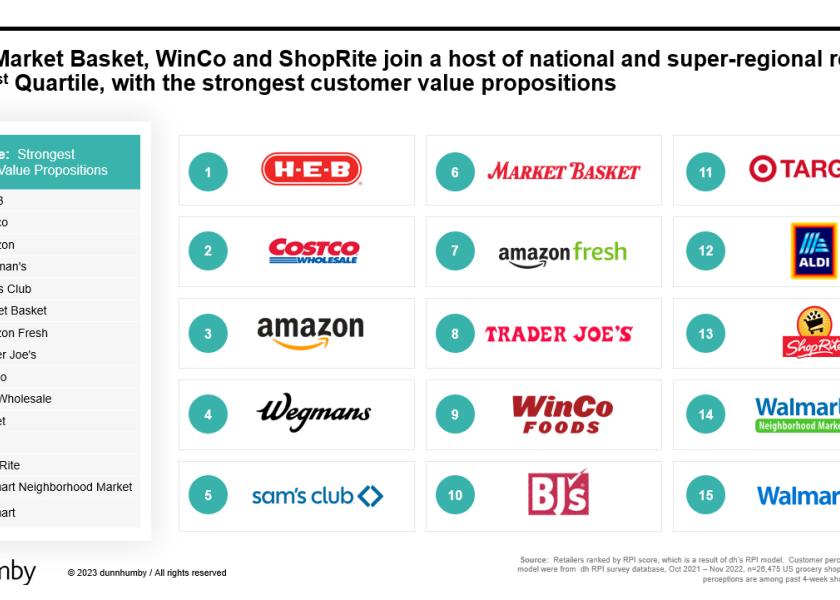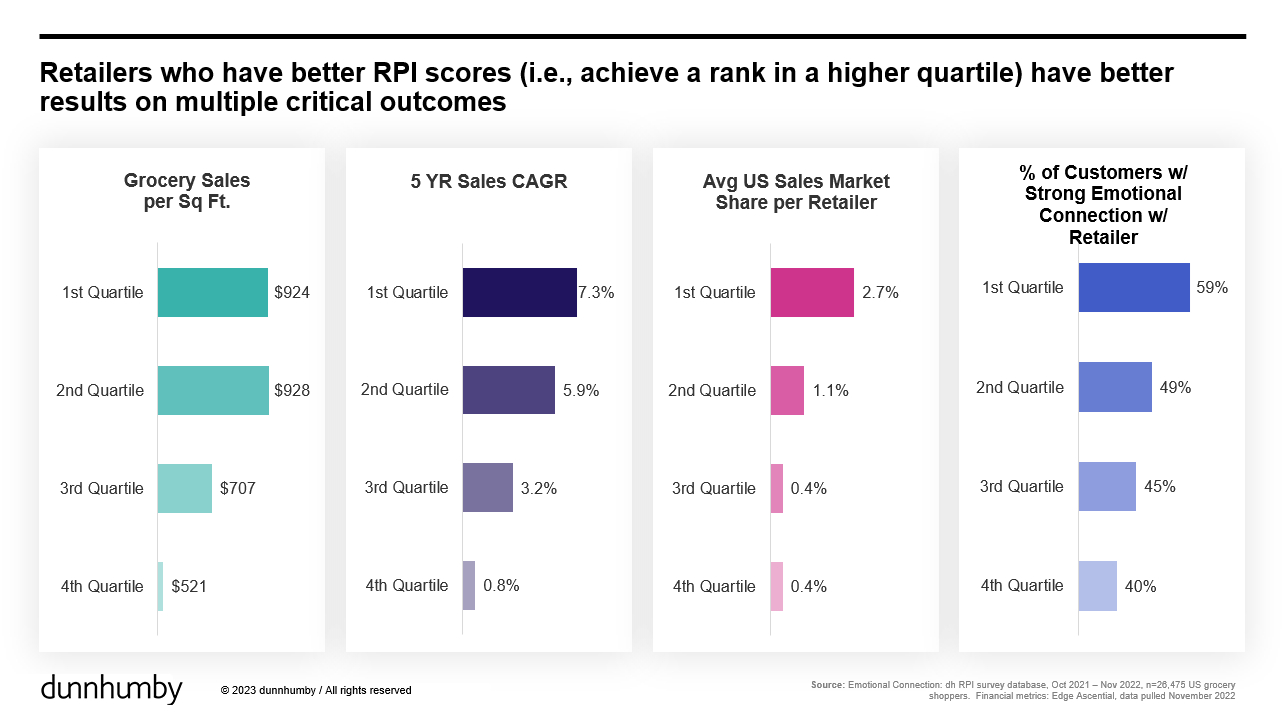Amazon falls to H-E-B after two years as top U.S. grocery retailer

Some takeaways, upfront:
- BJ’s Wholesale was the biggest mover in the Retailer Preference Index over the last three years, climbing from 27th to 10th place in 2022, a 17-place jump in rankings.
- Price is the top consumer need across all income brackets, including 66% of people making $50,000 to $74,999 and 53% making more than $200,000.
- Personalized prices, promotions and rewards became three times more important at driving overall price perception compared to 2019.
Consumers are back to favoring grocery stores over the online retailer giant for their food purchases.
Three years after the pandemic upturned the grocery industry, H-E-B has regained its leadership position from Amazon, with Costco following closely behind in second place, according to the sixth annual Dunnhumby Retailer Preference Index, stated in a news release.
Released by customer data science consultant Dunnhumby, the study examines the $1 trillion U.S. grocery market.
Amazon fell to third, while Wegmans took the fourth spot for the third year in a row.
“We believe this report can serve as a blueprint to help grocers improve their competitive positions, while providing key findings for marketing and consumer preferences,” Matt O’Grady, Dunnhumby's president of the Americas, said in the release.

The 11 additional retailers with the highest overall customer preference index scores are:
5. Sam’s Club.
6. Market Basket.
7. Amazon Fresh.
8. Trader Joe’s.
9. Winco.
10. BJ’s Wholesale.
11. Target.
12. Aldi.
13. ShopRite.
14. Walmart Neighborhood Market.
15. Walmart.
“In 2017 we set out on a journey to understand how customers’ preferences and retailers’ financial results predicted which retailers would last,” O’Grady said. “But little did we know that in the ensuing six years consumers and retailers would have a lifetime of difficulties, including a pandemic that shook consumer behavior and the global economy, a prolonged period of supply change struggles, and a once-in-a-generation inflation crisis.”
This Dunnhumby RPI approach to ranking grocers combines financial results with customer perception. It includes the largest 63 retailers in the industry that sell everyday food and nonfood household items.
The financial data used in the Dunnhumby model comes from Edge Ascential, and the customer perception data is sourced from Dunnhumby’s annual survey of 10,000 American grocery shoppers that was conducted in November 2022.

Also, Dunnhumby analyzed survey data from an additional 20,000 consumers surveyed in October 2021 (10,000 consumers) and May 2022 (10,000 consumers) and combined that data with the November 2022 survey (10,000 consumers) to understand the five drivers of the value proposition: price, promotions and rewards; speed and convenience; quality; digital; and operations.
These are some key findings from the study.
Fierce battle at the top between U.S. grocers.
Over the six-year history of the U.S. Grocery RPI, there has been a fierce battle between the top retailers. In 2020 and 2021, the pandemic helped propel and then solidify Amazon as the top grocery retailer over H-E-B, Trader Joe’s and Wegmans, as Amazon’s value proposition excels at both saving customers time and providing a seamless e-commerce experience. But in 2022, H-E-B reclaimed the top spot due to its ability to deliver a combination of better savings and better-quality experience/assortment, according to the release.
Digital has staying power but is no longer as key to driving short-term retailer momentum as it was from 2020 to 2021.
The pandemic increased the percentage of Americans shopping online for groceries from 39% to 50% of the country — an 11-percentage-point rise — and, despite record inflation, more than half of those people remained online grocery shoppers in 2022. As a result, there are 9.4 million more omnichannel households today than there were in 2019 with a combined grocery budget of $4.9 billion.
Retailers in the top quartile outperform the rest of the market in delivering superior customer benefits, savings or both.
Top-quartile retailers have an average compounded average growth rate (CAGR) of 7.3% compared to third-quartile retailers with a 3.2% CAGR. Also, 59% of customers of those first-quartile retailers have a strong emotional connection with retailers compared to 45% of customers of third-quartile retailers.
Amazon is still superior in online shopping, but all other online retailers are closing the gap.
Fifty-two percent of customers of first-quartile retailers reported they have an easy online shopping experience, an increase of 13% from 2019. The top six retailers for digital are:
- Amazon.
- Amazon Fresh.
- Target.
- Sam’s Club.
- Walmart.
- Walmart Neighborhood Market.
Club stores are gaining momentum with three of the top 10 spots in the first quartile now occupied by club stores.
Costco (2), Sam’s Club (5) and BJ’s Wholesale (10) achieved a high rank through a combination of top-notch dependability and saving customers money while delivering a seamless experience. In Dunnhumby’s 2019 RPI, no club store ranked higher than seventh.
BJ’s Wholesale was the biggest mover in the RPI over the last three years, climbing from 27th place to 10th place in 2022, a 17-place jump in rankings.
Schnucks climbed 16 spots and currently sits in the second quartile overall. Other big ranking movers not in the first quartile overall but improving were: Food Lion (14 spots up), Food4Less/FoodsCo (12 spots up), Weis (10 spots up) and Food City (nine spots up).
These five retailers have two things most in common: displaying superior ability to navigate supply chain issues by improving ranking in the operations pillar, which measures out-of-stock perceptions among other things, and having existing strengths or made significant gains in competitive position to save customers money.
The full RPI report can be accessed on the Dunnbhumby website, after inputting some data.







